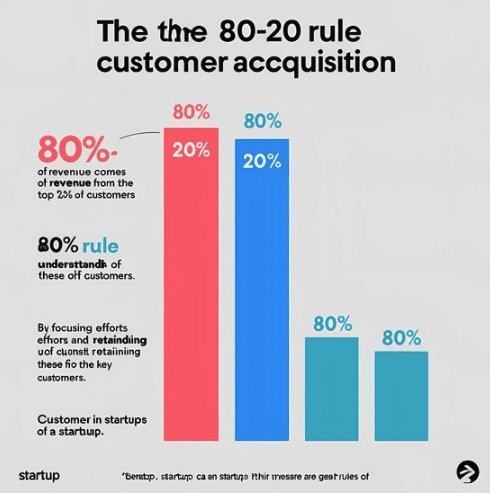
What is the 80-20 rule? (Explained With Examples)
The 80-20 rule, also known as the Pareto Principle, is a concept that suggests that 80% of the results or consequences come from 20% of the causes or efforts. This rule can be applied to various aspects of life and business, helping us understand how a small portion can have a significant impact
What is the 80-20 rule?
The 80-20 rule, as mentioned earlier, is based on the idea that there is an imbalance between inputs and outputs. In other words, a minority of factors often contribute to the majority of results. The rule was named after the Italian economist Vilfredo Pareto, who observed that 80% of the land in Italy was owned by 20% of the population.
The 80-20 rule, also known as the Pareto Principle, has gained significant recognition across various fields due to its applicability and effectiveness. It has been widely used in business, economics, time management, and even personal development.
1.1 - Definition of 80-20
The 80-20 rule can be defined as a principle stating that approximately 80% of the effects come from 20% of the causes. This concept can be applied to numerous scenarios, providing valuable insights into the distribution of resources and outcomes. For example, 80% of a company's profits may come from just 20% of its customers, or 80% of a team's productivity may result from the efforts of 20% of its members.
Understanding the 80-20 rule allows individuals and organizations to identify the vital few factors that have the most significant impact on their desired outcomes. By focusing on these critical areas, they can allocate resources and efforts more effectively, maximizing their results with crm automation.
1.2 - Advantages of 80-20
The 80-20 rule brings several advantages when applied correctly. First and foremost, it helps identify the critical few factors that have the most impact. By recognizing the 20% of causes that generate 80% of the effects, individuals and organizations can prioritize their efforts and resources accordingly. This optimization leads to increased efficiency and productivity.
Moreover, the 80-20 rule allows for better time management. By identifying the tasks or activities that contribute the most to the desired outcomes, individuals can prioritize them and allocate their time accordingly. This approach ensures that the most important activities receive the necessary attention and resources.
Additionally, the 80-20 rule promotes efficiency and simplifies decision-making. By understanding the vital few factors, individuals and organizations can eliminate or reduce the less important ones, freeing up resources and reducing complexity. This principle encourages strategic thinking, as it prompts the examination of the factors driving success and the potential to replicate them.
1.3 - Disadvantages of 80-20
While the 80-20 rule can be a valuable tool, it does have its limitations. One drawback is the difficulty of accurately determining the exact distribution of causes and effects. The 80-20 ratio is often used as a rough guideline, and variations can occur depending on the context. It is crucial to recognize that the distribution may not always be precisely 80-20 and that different situations may require different ratios.
Another disadvantage is the risk of oversimplification. Relying solely on the 80-20 rule without considering other factors can lead to an incomplete understanding of complex situations. It is essential to adopt a balanced approach, taking into account the nuances and interdependencies between different factors. While the 80-20 rule provides valuable insights, it should not be the sole determinant of decision-making.
Despite these limitations, the 80-20 rule remains a powerful concept that can guide individuals and organizations towards more effective resource allocation, improved productivity, and better decision-making.
Examples of 80-20

2.1 - Example in a Startup Context
In the context of a startup, the 80-20 rule can be applied to customer acquisition. It is often observed that around 80% of the revenue comes from the top 20% of customers. By focusing efforts on understanding and retaining these key customers, startups can maximize their revenue and achieve sustainable growth.
For example, let's consider a hypothetical startup called "TechSolutions." They offer a range of software solutions for small businesses. Applying the 80-20 rule, TechSolutions identifies that 80% of their revenue comes from the top 20% of their customers. These customers are typically larger businesses with complex software needs.
To cater to this vital customer segment, TechSolutions invests in dedicated account managers who provide personalized support and tailored solutions. By understanding the unique requirements of these key customers, TechSolutions can deliver exceptional value and ensure their long-term satisfaction.
Additionally, TechSolutions focuses on building strong relationships with these key customers by regularly engaging with them through surveys, feedback sessions, and exclusive events. This proactive approach helps TechSolutions stay ahead of their competitors and secure repeat business from their most valuable customers.

2.2 - Example in a Consulting Context
Within the consulting industry, the 80-20 rule can be seen in terms of client satisfaction. Approximately 80% of a consultant's success may result from the top 20% of their clients. By delivering exceptional value to these clients and cultivating long-term relationships, consultants can establish a strong reputation and secure repeat business.
Let's imagine a consulting firm called "Strategic Solutions" that offers strategic planning and implementation services to various industries. Applying the 80-20 rule, Strategic Solutions identifies that 80% of their revenue comes from the top 20% of their clients. These clients are typically large corporations with complex strategic challenges.
To ensure the success of these key clients, Strategic Solutions assigns their most experienced consultants to work closely with them. These consultants have a deep understanding of the industry and possess the necessary expertise to provide valuable insights and recommendations.
Furthermore, Strategic Solutions goes the extra mile by offering ongoing support and follow-up services to their top clients. This includes regular check-ins, performance evaluations, and strategic reviews. By continuously demonstrating their commitment to these clients' success, Strategic Solutions solidifies their reputation as a trusted consulting partner.

2.3 - Example in a Digital Marketing Agency Context
A digital marketing agency can apply the 80-20 rule to their marketing efforts. It is often found that 80% of the website traffic or conversions come from 20% of the marketing channels or campaigns. By identifying and optimizing the most effective channels, the agency can allocate resources wisely and improve overall marketing performance by using CRM for Agencies.
Let's consider a digital marketing agency called "DigitalEdge" that specializes in helping businesses increase their online visibility. Applying the 80-20 rule, DigitalEdge analyzes their marketing data and discovers that 80% of their website traffic and conversions are generated from 20% of their marketing channels or campaigns.
To maximize their marketing efforts, DigitalEdge focuses on optimizing these top-performing channels. They conduct thorough research and analysis to understand the target audience, messaging, and creative elements that resonate the most with their high-converting channels.
Additionally, DigitalEdge experiments with different strategies and tactics within these top channels to further enhance their performance. They constantly monitor key metrics, such as click-through rates, conversion rates, and return on ad spend, to identify areas for improvement and make data-driven decisions.
By applying the 80-20 rule to their digital marketing efforts, DigitalEdge can allocate their resources strategically, ensuring that they invest more time, effort, and budget into the channels that generate the highest returns. This approach allows them to optimize their overall marketing performance and drive better results for their clients.

2.4 - Example with Analogies
To further illustrate the 80-20 rule, let's consider some analogies. Think about a closet filled with clothes; you probably wear 20% of your clothes 80% of the time. In a social setting, you might find that 80% of the conversations are dominated by 20% of the participants. These examples demonstrate how the principle can be observed in various aspects of life.
Imagine opening your closet and realizing that you have a wide variety of clothes, but you tend to gravitate towards a small portion of your wardrobe. This phenomenon aligns with the 80-20 rule, where you wear 20% of your clothes 80% of the time. These favorite pieces of clothing are comfortable, versatile, and perfectly suited to your personal style.
In a social gathering, you may notice that a small group of individuals tends to dominate the conversations. These individuals contribute the most to the discussions, share interesting stories, and captivate the attention of others. This scenario reflects the 80-20 rule, where 20% of the participants generate 80% of the conversation.
These analogies highlight how the 80-20 rule extends beyond business contexts and applies to everyday situations. By recognizing this principle in various aspects of life, we can gain a deeper understanding of its significance and apply it to optimize our personal and professional endeavors.
In conclusion, the 80-20 rule, or Pareto Principle, highlights the disproportionate impact of a few factors compared to the rest. Understanding and applying this rule can help individuals and businesses optimize their efforts, prioritize tasks, and achieve higher efficiency. By focusing on the vital few, we can maximize results and drive success in a more targeted and strategic manner.











































































































































































































